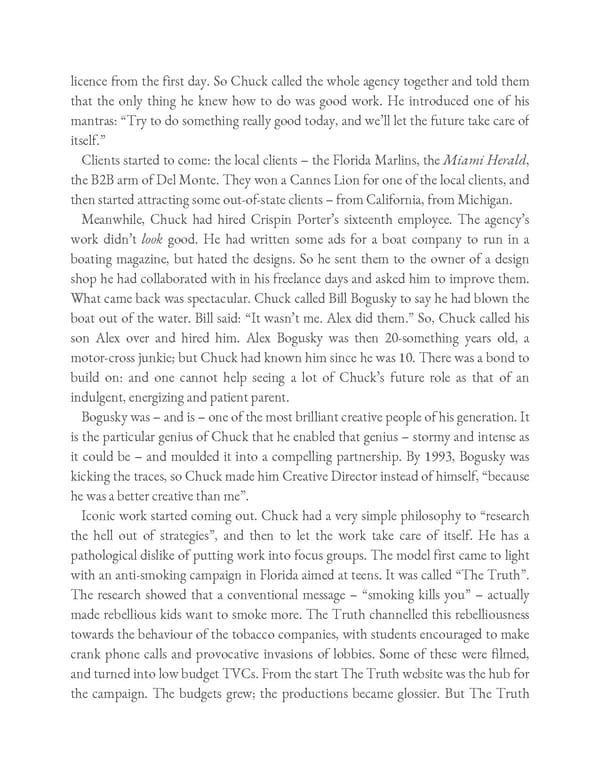licence from the first day. So Chuck called the whole agency together and told them that the only thing he knew how to do was good work. He introduced one of his mantras: “Try to do something really good today, and we’ll let the future take care of itself.” Clients started to come: the local clients – the Florida Marlins, the Miami Herald, the B2B arm of Del Monte. They won a Cannes Lion for one of the local clients, and then started attracting some out-of-state clients – from California, from Michigan. Meanwhile, Chuck had hired Crispin Porter’s sixteenth employee. The agency’s work didn’t look good. He had written some ads for a boat company to run in a boating magazine, but hated the designs. So he sent them to the owner of a design shop he had collaborated with in his freelance days and asked him to improve them. What came back was spectacular. Chuck called Bill Bogusky to say he had blown the boat out of the water. Bill said: “It wasn’t me. Alex did them.” So, Chuck called his son Alex over and hired him. Alex Bogusky was then 20-something years old, a motor-cross junkie; but Chuck had known him since he was 10. There was a bond to build on: and one cannot help seeing a lot of Chuck’s future role as that of an indulgent, energizing and patient parent. Bogusky was – and is – one of the most brilliant creative people of his generation. It is the particular genius of Chuck that he enabled that genius – stormy and intense as it could be – and moulded it into a compelling partnership. By 1993, Bogusky was kicking the traces, so Chuck made him Creative Director instead of himself, “because he was a better creative than me”. Iconic work started coming out. Chuck had a very simple philosophy to “research the hell out of strategies”, and then to let the work take care of itself. He has a pathological dislike of putting work into focus groups. The model first came to light with an anti-smoking campaign in Florida aimed at teens. It was called “The Truth”. The research showed that a conventional message – “smoking kills you” – actually made rebellious kids want to smoke more. The Truth channelled this rebelliousness towards the behaviour of the tobacco companies, with students encouraged to make crank phone calls and provocative invasions of lobbies. Some of these were filmed, and turned into low budget TVCs. From the start The Truth website was the hub for the campaign. The budgets grew; the productions became glossier. But The Truth
 Ogilvy on Advertising in the Digital Age Page 389 Page 391
Ogilvy on Advertising in the Digital Age Page 389 Page 391